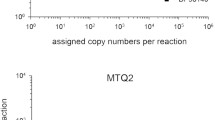Abstract
Due to its higher trade value, a broad range of adulterations of Basmati rice with cheaper rice varieties can be found on the market. A duplex digital droplet PCR (ddPCR) assay was developed to test rice samples, labeled as “Basmati,” for their authenticity. The new ddPCR assay is based on the real-time PCR (rtPCR) method published previously. It showed to be able to screen for non-Basmati rice contents in the range of 1 % or higher. As digital PCR does not require calibrators for the quantification, the method is more economic, compared to rtPCR or microsatellite analysis (MA). It is also less time-consuming than MA and an alternative method for the verification of rtPCR results. Comparing results gained by all three methods revealed best correlation between ddPCR and MA.



Similar content being viewed by others
References
British Retail Consortium (2005) Code of practice on Basmati rice. http://www.brc.org.uk/Downloads/Basmati_Code.pdf. Accessed on June 2013
Archak S, Lakshminarayanareddy V, Nagaraju J (2007) High-throughput multiplex microsatellite marker assay for detection and quantification of adulteration in Basmati rice (Oryza sativa). Electrophoresis 28:2396–2405
Vemireddy LR, Archak S, Nagaraju J (2007) Capillary electrophoresis is essential for microsatellite marker based detection and quantification of adulteration of Basmati rice (Oryza sativa). J Agric Food Chem 55(20):8112–8117
Bucher TB, Fridez F, Köppel R (2014) Duplex real-time PCR for the determination of non-Basmati rice in Basmati rice (Oryza sativa). Eur Food Res Technol 238:417–423
Morisset D, Stebih D, Milavec M, Gruden K, Zel J (2013) Quantitative analysis of food and feed samples with droplet digital PCR. PLoS One 8(5):e62583
Floren C, Wiedemann I, Brenig B, Schütz E, Beck J (2015) Species identification and quantification in meat and meat products using droplet digital PCR (ddPCR. Food Chem 173:1054–1058
Sanders R, Huggett JF, Bushell CA, Cowen S, Scott DJ, Foy CA (2011) Evaluation of digital PCR for absolute DNA quantification. Anal Chem 83(17):6474–6484
Dube S, Qin J, Ramakrishnan R (2008) Mathematical analysis of copy number variation in a DNA sample using digital PCR on a nanofluidic device. PLoS One 3(8):e2876. doi:10.1371/journal.pone.0002876
Majumdar N, Wessel T, Marks J (2015) Digital PCR modeling for maximal sensitivity, dynamic range and measurement precision. PLoS one 10(3):e0118833. doi:10.1371/journal.pone.0118833
McDermott GP, Do D, Litterst CM, Maar D, Hindson CM, Steenblock ER, Legler TC, Jouvenot Y, Marrs SH, Bemis A, Shah P, Wong J, Wang S, Sally D, Javier L, Dinio T, Han C, Brackbill TP, Hodges SP, Ling Y, Klitgord N, Carman GJ, Berman JR, KoehlerR T, Hiddessen AL, Walse P, Bousse L, Tzonev S, Hefner E, Hindson BJ, Cauly TH, Hamby K, Patel VP, Regan JF, Wyatt PW, Karlin-Neumann GA, Stumbo DP, Lowe AJ (2013) Multiplexed target detection using DNA-binding dye chemistry in droplet digital PCR. Anal Chem 85(23):11619–11627
Miotke L, Lau BT, Rumma TR, Ji HP (2014) High sensitivity detection and quantitation of DNA copy number and single nucleotide variants with single color droplet digital PCR. Anal Chem 86(5):2618–2624
Food and Environment Research Agency (2010) Sand Hutton, York, UK. http://www.fapas.com. Accessed on August 2015
Eurofins Medigenomix GmbH (2015) Anzinger Str. 7a, 85560 Ebersberg, Germany. http://www.eurofins.de. Accessed on August 2015
Lopez SJ (2008) TaqMan based real time PCR method for quantitative detection of Basmati rice adulteration with non-Basmati rice. Eur Food Res Technol 227:619–622
Bradbury LMT, Fitzgerald TL, Henry RJ, Jin Q, Waters DLE (2005) The gene for fragrance in rice. Plant Biotechnol J 3:363–370
Molecular and Biochemical Analytical Services, Bayer BioScience N.V. Belgium (2006) Grain testing method for the detection of rice GM event LLRice601 using RT-PCR protocols PGS0505 and PGS0476. http://gmo-crl.jrc.ec.europa.eu/LLRice601update.htm
Wood R, Woolfe M (2007) Information Bulletins on Methods of Analysis and Sampling N 75. Food Standards Agency FSA, UK. http://tna.europarchive.org/20111030113958/http://www.food.gov.uk/multimedia/pdfs/075a.pdf
Woolfe M (2008) Protocol for the quantitative analysis of adulteration of Basmati rice. Personal communication, Food Standards Agency FSA, UK
Acknowledgments
We thank the Food Control Authority of the Canton Zürich for providing the resources for this work.
Author information
Authors and Affiliations
Corresponding author
Ethics declarations
Conflict of interest
None.
Compliance with Ethics Requirements
This article does not contain any studies with human or animal subjects.
Rights and permissions
About this article
Cite this article
Bucher, T.B., Köppel, R. Duplex digital droplet PCR for the determination of non-Basmati rice in Basmati rice (Oryza sativa) on the base of a deletion in the fragrant gene. Eur Food Res Technol 242, 927–934 (2016). https://doi.org/10.1007/s00217-015-2599-3
Received:
Revised:
Accepted:
Published:
Issue Date:
DOI: https://doi.org/10.1007/s00217-015-2599-3




